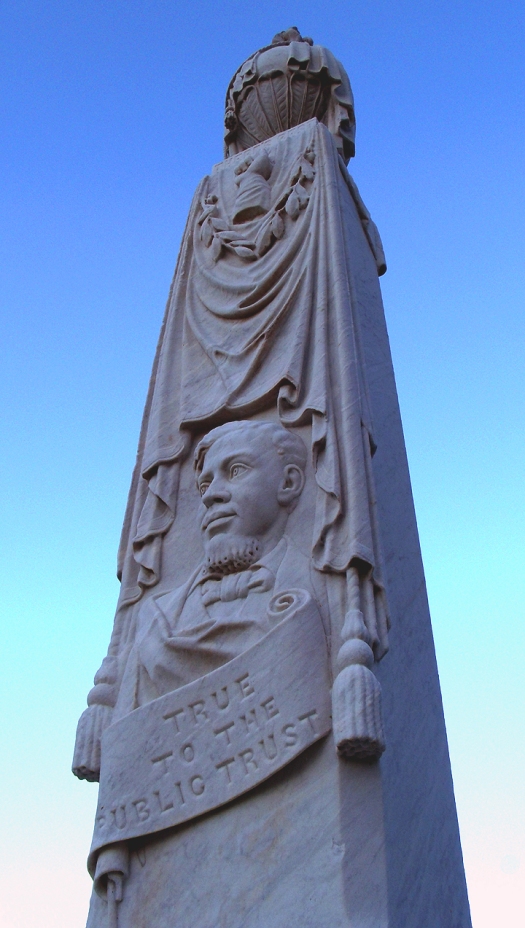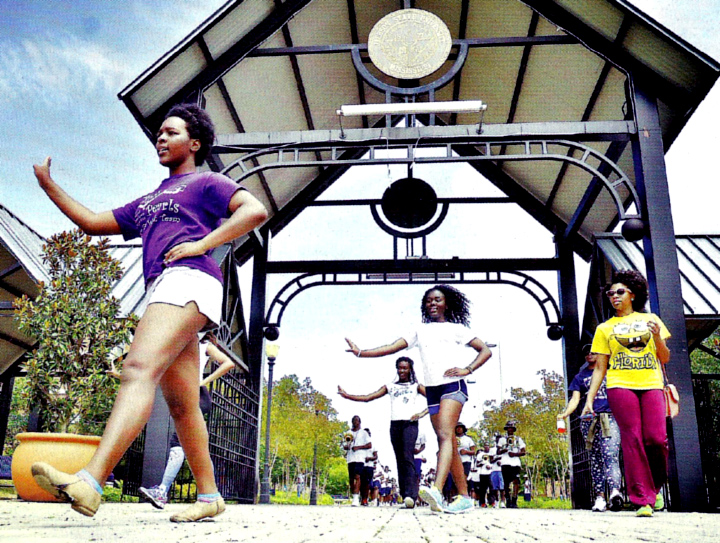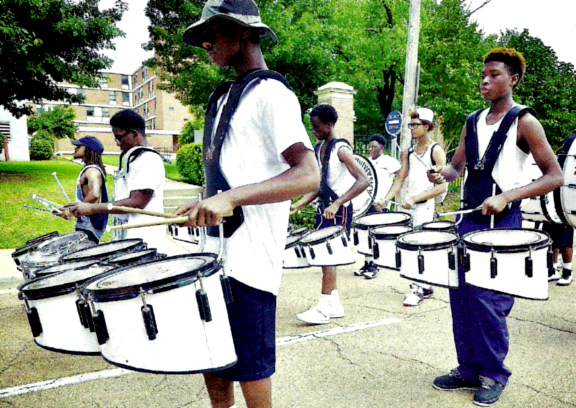Rural Politicians
Balancing on the Barstool


The devil on the rocks
Before there was a wild West, there was a wild Southwest, and Mississippi was its cornerstone. At that time, any city or town with a berth on a river (which most of them had in those days before rail) eventually found itself host to a riverfront district subject to laws that were either non-existent or non-enforced.

Natchez-Under-the-Hill is a prime example of such a red light district, but Jackson harbored a similar section during its early development. Audubon, who visited the area in the 1820s, said that the banks of the Pearl under LeFleur’s Bluff were filled with “low dives of the worst sort.” One of the most notorious dens of iniquity was located just below the corner of North and Amite Street, within spitting distance of the Old Capitol itself, now the site of the Winter Building housing the Mississippi Department of Archives and History. As fortified as these fiefs of John Barleycorn were, they soon found themselves inundated by the spirit of Protestant evangelism that was spilling its way down from the Northeast. The first churches were established here well before Mississippi became a state, but the nineteenth century revivals increased their numbers a thousand fold, and their influence on state laws regarding alcohol were (and still are) formidable.
Mississippi is still legally “dry” in that the state never has repealed Prohibition. According to the Mississippi Code of 1972, “The policy of this state is reannounced in favor of prohibition of the manufacture, sale, distribution, possession and transportation of intoxicating liquor; and the provisions against such manufacture, sale, distribution, possession and transportation of intoxicating liquor, as contained in Chapter 31 of Title 97, Mississippi Code of 1972 and elsewhere, are hereby redeclared the law of this state.” Instead, the state has granted counties and municipalities to “come out from under the dry law” in local option elections.
William F. Shughart II, an economist at the University of Mississippi, wrote in an article for the Independent Institute that “when national Prohibition was repealed in 1933, so that the federal government would be able to offset declining income-tax revenues by reintroducing selective excise taxes on distilled spirits, wine, and beer, the regulation of alcohol sales was left to the individual states. Mississippi finally went “wet” in 1966, choosing to become one of 18 jurisdictions operating state-owned wholesale liquor distribution systems. Other states, like Pennsylvania and Virginia, sell alcoholic beverages directly to consumers through state-run liquor stores, and still others, like California, simply tax liquor sales at retail.”
The ABCs of alcohol
In Mississippi, the Office of Alcoholic Beverage Control (ABC) of the Mississippi State Tax Commission is responsible for the purchasing and distribution of wines and spirits. The ABC buys about 3,000 brands and package sizes of wine and ardent spirits from vintners and distillers. As the enforcer of the state’s liquor laws, ABC is also responsible for maintaining fair and equitable enforcement of the Local Option ABC laws and the prohibition laws. Twenty-eight certified enforcement agents are stationed across the state, most of whom maintain offices at the Tax Commission District Offices. Since 1966, ABC agents have successfully prosecuted in excess of 36,000 liquor law violations and destroyed approximately 2,500 illicit whiskey stills. David Wilson, Chief of Enforcement for ABC, said, “We have much more of a problem with unlicensed sellers, but we still catch a lot of moonshiners. You might say that we have a lot of unlicensed distribution points, and that’s a continuing concern. If you’ll look at the map, you’ll see that almost half of the state is still dry, and if there’s drinking going on in those parts, there must be an unlicensed distributor.”
State law requires the ABC to mark up the wholesale price on alcohol by 27.5% over what it pays its suppliers. This markup generates about $32,500,000 in revenue for the state annually, not counting the sales taxes which are also collected on retail liquor sales. The actual mark-up for the general fund is 24.5; the other three percent, dictated by statute, goes to the Mental Health Association, purportedly for alcohol rehabilitation and treatment.
“As it sits now, the state of Mississippi itself controls what sort of beer, wine or spirits you might legally prefer to have at your dinner parties,” Shughart said. “Until any given alcoholic beverage has been included in the state list (ABC’s “Price Book” or on its monthly “Fine Wine List”), it is unavailable to the citizens of Mississippi.”

“We add various sizes of products according to consumer needs and we work with the companies on these sizes, too. Sometimes the company will dictate when they want a product in a particular part of the country and in what size, so it’s a little more involved (to add a particular product) than people sometimes think. We do everything we can to give the consumers what they want,” Perkins added. “We do all the work of getting the pricing, getting the case or whatever ordered, getting it in here and getting it out to them.”
Mike Cashion, former executive director of the Mississippi Restaurant Association, said, “There are some aspects of the system that work well. The issue of being able to pick up the phone and order a product from one central location is pretty convenient. But overall with the system you just need to look at it and see if there’s a better way to do business. If you look at what happened a couple of months ago (October 17) when the ABC had to shut down (due to a problem with computer software), I think that’s indicative of the fact that there are some operational issues that need to be reviewed,” Cashion said. “There were several areas that needed to be fixed. From a business perspective you need to look at what caused those problems and see what those long-term fixes are.”
Cashion said that the ABC has made some inroads in procedures on how to special order and has made some progress on that, but he points out that when it comes to blanket availability there are a lot of factors involved. “It’s very, very complicated and there’s no easy fix and no easy answers to the questions that are out there,” Cashion said.
Incidentally, the spirit and wine law is separate from the beer and light wine law; beer and light wine permits are issued by the Miscellaneous Tax Division of the state tax commission. This division registers all beer and light wine labels and issues permits to wholesalers. The tax commission issues wholesale beer permits to distributors (wholesalers), and beer permits to retailers. The wholesalers distribute beers and light wines to retailers, which number about seven or eight thousand in the state, including bars, restaurants, retail groceries and convenience stores. The only direct dealing the ABC has to do with beer is that ABC agents enforce the beer laws.
Of booze and bods
The way the body disposes of alcohol has been on record since the nineteenth century, having first been described by the German chemist von Liebig. Before Liebig, it was generally assumed that alcohol simply passed through the body without change, only to be eventually excreted in its original form by the skin, lungs and kidneys.
Nothing could be further from the truth. Most foods (and alcohol is a food, albeit a poor one) need to be broken down and remodeled by various agents in the mouth and stomach in order to be oxidized in the body. But ethyl alcohol doesn’t need any sort of preparation; it is as naturally as digestible as water, and can be assimilated into the body by the stomach, the small intestine, or even the large intestine (yes, you can get drunk from a vodka enema). Since alcohol has no effect until it reaches the bloodstream, the key to the effects of alcohol on the central nervous system lies in what as known as the blood alcohol level (BAL). It is recorded in milligrams of alcohol per 100 milliliters of blood, or milligrams percent. For example, a BAL of .10 means that 1/10 of 1 percent (or 1/1000) of your total blood content is alcohol.

Alcohol is almost unique in that it has a dual effect on the central nervous system. Briefly, on the upswing curve the blood alcohol level, it acts as a stimulant. After the first drink or two, most drinkers feel animated and most can even perform better in tests of eye-hand coordination. But relaxation is another common reason for drinking, especially in the context of leisure time. Refreshment might also be an aspect of this: a cold beer on a hot summer day, for instance, or a warm toddy on a cold winter night. Then again, for most people, a drink or two is enough to cause an alteration in mood, and for most people this change is pleasurable. You’ll find people explaining that having a few drinks after a round of hectic activity—say a day at work—is a relaxing activity. Hence we have that institution with the blithe name of happy hour, during which for an hour or more during the afternoons you can drink at reduced prices, presumably with the result of becoming happy. Not so recently, since some critics have voiced the complaint that drinking should not be promoted as a key to happiness, some of the more progressive drinking establishments have instituted what is known as an “attitude adjustment hour.”
Yet however enjoyable or pleasurable a few drinks can be, a steady increase in the levels of alcohol in the blood has less fortunate effects. After several drinks, disorientation is followed by mental confusion, dizziness, and increased muscular incoordination. Further intoxication usually results in staggering gait and slurred speech, marked muscular incoordination, the inability to stand or walk, vomiting and incontinence, impaired consciousness and stupor.
When the party’s over
Drunkenness is condemned down through the ages. “At the first cup,” a Japanese poet wrote, man drinks wine. At the second cup, wine drinks wine. At the third cup, wine drinks man.” Genghis Khan recommended that a soldier not get drunk more than once a week. “It would be better if he did not get drunk at all,” he wrote, “but one should not expect the impossible.” The Jews filled the Old Testament with denunciations of drunkenness; the “strong drink” of the Old Testament is considered to be undiluted wine, since distilled spirits didn’t come about until around 800 A.D. The lyric poet Alcaeus wrote of habitual excess that “One that hath wine as a chain about his wits, such a one lives no life at all.”
Throughout history, it was obvious that no matter how much time someone spent in the gutter or in the stocks, or how often they were threatened with hellfire and brimstone, no matter how much their family begged and beseeched them to quit drinking, some people just kept getting drunk. 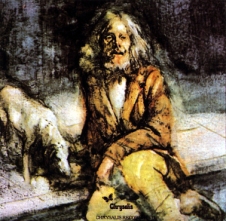
Alcoholism is a complex medical and psychological condition, and many theories have been put forward to explain the phenomenon. Initially, of course, alcoholics were simply dismissed as inveterate sinners, but as people began losing faith (so to speak) in sin as an all-embracing explanation of deviant behavior, they began to consider that perhaps something was constitutionally wrong with this sort of drinker. The concept of alcoholism as a disease finally congealed around the middle of the twentieth century in the studies of a researcher at the Yale Center for Alcohol Studies named E.M. Jellinek.
Jellinek published influential research which appeared to confirm the disease status of alcoholism by showing that over time the condition was predictably progressive, with distinct and recognizable phases to its natural history. Jellinek’s masterwork, The Disease Concept of Alcoholism, was published in 1960. When he died in 1963, the disease concept, both as idea and work, was seen as his supreme accomplishment. Even though Jellinek invented a scientific doctorate for himself which no university ever awarded, the significance of his work remains profound. His recommendation of total abstinence remains the basis for the most effective treatments available today, including the programs at the Betty Ford Clinic and other treatment facilities and abstinence, along with the celebrated 12-step process, are the basic tenets of Alcoholics Anonymous, widely regarded as the most successful recovery program for alcoholics the world over.
Patsy Hillard, former associate director and outreach coordinator for the National Council on Alcoholism and Drug Dependence of the Central Mississippi Area, states that according to the Diagnostic and Statistic Manual for Mental Health, “alcoholism is a disease.”
The, National Council on Alcoholism and Drug Dependence (NCADD) Inc. is a national non-profit organization combating alcoholism, other drug addictions and related problems through its National Office, 200 state and local affiliates and thousands of volunteers in communities throughout the nation. The National Council on Alcoholism and Drug Dependence of the Central Mississippi Area was established in 1949. Hugh Barkley, executive director of the NCADD of Central Mississippi said, “The treatment programs that we deal with are based on the 12-step programs that have been used by Alcoholics Anonymous for over sixty years. An alcoholic is an alcoholic; one drink is just going to trigger his mind to going back to start drinking rather than coping with life on a regular basis.”

“That’s just the way we do things in Mississippi,” Barkley said. “We wait until the last or the next to the last year before the government threatens to take away funds, then we pass the law. We always procrastinate. But according to a recent report, our DUI rates have decreased, whereas in other states, such as South Carolina, they have increased. And that’s directly attributable to the new DUI law and its enforcement.”
Barkley also said that the state’s allocation of tax monies for treatment has also undergone revisions. “Back in the 70s, the legislature put a tax on hard liquor that was to be used for alcohol and drug treatment. That was true for a few years, but then the state got into a budget crunch and the Legislature saw fit to say, ‘Okay, we don’t want to earmark that money for alcohol and drug treatment, we’ll put it into the general fund along with the other funds, and we’ll allocate funds to the Mississippi Department of Mental Health, and they can decide how much they’re going to put into treatment.’”
“Basically, one out of ten people who drink in this country will become alcoholics,” Hillard said. “That’s probably world-wide as well. But the one thing that’s interesting about traffic accidents and traffic fatalities (involving alcohol) is that they are not caused by alcoholics but by people who might go out and drink more than they’re accustomed to. Most alcohol-related traffic fatalities are caused by people who are not alcoholics, not regular drinkers. One of the things we address in our prevention programs is to talk about risk factors,” Hillard explained. “Risk factors are those factors which might make a person more likely to become addicted to alcohol or any other drug. They include a family history of alcoholism or addiction or living in a place where drugs and alcohol are readily available. You can’t always move a child out of a neighborhood, but you can alert him or her to the risk factors they face.”
Barkley said that many people who are addicted to alcohol are abusive, not only to themselves, but to their family members, and this abuse is often more subtle than physical or verbal: such elements as the erosion of family finances, the upkeep of homes and compassion for others are problems spread across every social and economic level, every race and every gender.
“Alcoholism has so many facets that you can compare with other diseases,” Hillard said. “It’s treatable. The recovery rate is not what we’d like for it to be, but just because a person goes through treatment many times does not mean that we don’t hope that they might make it one day.”
Bottom line
During the holidays, law enforcement agencies across the state conduct “You Drink and Drive, You Lose” campaigns. Given the adjustment in the DUI laws that are now in accordance to federal standards, the state will have about a quarter of a million dollars at their disposal to put additional officers on the roads and to enhance patrols that are already in place, and while these efforts have reduced alcohol-related highway fatalities considerably, drinking and driving still leads to tragic consequences on a periodic basis. Drink responsibly, and always drive safely.
Red Mule
Jackson State University’s Baby Boom
Music lives in the heart of Jackson State University, and two of the most conspicuous components of that commitment to the expression, generation and perpetuation of music as essential elements of our culture are WJSU-FM, the city’s premiere source for living jazz, rhythm and blues and gospel, and the summa cum laude of bands, The Sonic Boom of the South.
The Jackson State University Marching Band was dubbed The Sonic Boom of the South by students in 1971. The band was initially formed of college enrollees and students from Lanier High School in the 1940s. Through the years it has become known for intricate precision marching and a jazz-infused, “big band” sound. The band has performed many halftime appearances for the Atlanta Falcons, Detroit Lions, New Orleans Saints and Cincinnati Bengals, and is a premiere attraction in halftime performances during football games and parades across Mississippi and in other states. This past June the Sonic Boom held their second band camp on the campus of Jackson State University in Jackson, attracting some 150 students. “The bulk of the students are from the South, from North Carolina, Georgia, Tennessee and Texas,” said Roderick Little Associate Director of Bands at JSU. “A lot of the camp this year is from Texas. There are several groups out of Dallas, Texas, and they brought maybe about 20 kids each. We also have students from Kansas City, Maryland, and most surprising a student from California.”
The camp is designed to provide extensive curriculum and teaching instruction of musical pedagogical approaches and marching fundamentals while providing a fun, strategic learning atmosphere for secondary school instrumentalists and band directors. Competencies will include leadership skills, social maturation, instrumental/musical growth, physical fitness and networking amongst students. Master classes were offered by the Sonic Boom band staff, including Leadership Skills, Classroom Management, Field Show Content, Arranging, Instrumental Pedagogy and more. Social events such as talent shows and dances were also held.
“We are continuing to reach out as music educators. I think that the college should be forerunners for secondary schools as it relates to teaching others how to be proficient,” Little said. “This camp is designed to continue to teach kids in music education at the secondary level. Because as I mentioned, I think that’s the job of collegiate programs: to help others. People should know about the continuing outreach of education from collegiate to the secondary sectors and the teaching of life skills.”
This past May, National Public Radio broadcast a feature story on the marching band at Edna Karr High School in New Orleans. The story focused on music education as not just another part of the school’s curriculum, but more as a lifeline for kids struggling against poverty, crime and urban decay, how marching bands keep kids off the street, give them a reason to come to school, and even get them into college.
“That story is very true to what we do here at Jackson State,” Little said. “As a matter of fact, the director, Christopher Herrero, is an alumnus of JSU. In particular, kids in those urban areas really take a liking to band, or really any sort of extracurricular activity for that matter because it helps keep them out of trouble. I think it told the story of really more than just one thing that a band can do. It’s more than teaching music. For a lot of students that come into collegiate bands, particularly from urban settings, the scholarships are very important because these are students whose parents would not be able to pay for school otherwise. So we do offer scholarships to students coming in, even though our scholarship budget isn’t as large as we could hope it would be. We do try to supplement the students who come here to Jackson State as much as we can. The recruiting is very competitive because every college wants the best students, the top students, so we go out and basically bid for students.”
One outstanding element of the band camp at JSU is the instruction of jazz to high school students. According to Little, this is an essential component of the experience Jackson State offers to the visiting students.
“Jazz lives here at Jackson State, and jazz is an art form that many people tend to run away from because it’s hard to understand because jazz is such an emotional kind of music; you have to be emotionally connected to it to actually play it,” Little said. “And I’ll be honest; it takes a special type of person to play music in general, but it takes a different type of person to play jazz because you have to connect to it. By implementing a jazz ensemble here at camp, we want to take those students who have that little something extra and teach them how to take it to the next level. All of these different ensembles together make up what we call a holistic band program. So the jazz ensemble plays a major role because it adds to that feeling of what we’re doing here. We have two great jazz ensemble directors, one of whom is on our band staff, and so what we wanted to do this year with camp is that we wanted to open it up, not just to subject the students to training in marching bands, but to teach them in ensemble work, and jazz is one of those ensembles.”
Henry Martinez is a trumpet player from Dallas. “I like the jazz band. We play our instruments in ensemble sessions, and then we go outside for the marching drill formations,” Henry said. It’s hard work, and they keep us on our toes, but I like the discipline, and I hope to bring that sense of discipline back to my school, how to be a leader and get everyone to work together instead of a lot of individuals just sticking up for themselves.”
“We’ve had a band at our school for a long time, but it’s like we change directors every year, so there’s not really a feeling of tradition like I’ve found here,” said Destiny Hopkins, a piccolo player and drum major from Atlanta. “I thought it was really going to be hard when I came here, but the staff really went out of their way to make us feel like we were part of something, part of a group. It’s like we’ve been doing this together forever. I’m looking forward to taking home of a piece of the musical tradition I’ve found here.”
Tarique McClendon from Atlanta, who plays baritone, said, “The pride that they instilled in us the very first day is so important, and that’s something I hope to bring home. The very first day, when we walked into orientation, Mr. Little got us all together and called us the ‘Baby Boom’. At that moment, and from then on, we were like family, we were all really close, it was like Destiny said, it was like we’d all been doing this together forever.”
In addition to the classes for students, the band camp at Jackson State also offers instruction for music educators who attend. “We have sessions with directors to help them with their preparations with their bands. Also, the thing which I consider most important, is that they come together from different parts of the United States and discuss problems that they might be having, holding round table discussions on how to fix those problems. I think that’s the most important thing. But coupled with that, we as advanced teachers at Jackson State sit them down and talk to them about things that can improve their programs, and that’s the gist of those classes.”
Carleton Cooper, of Wilmer Hutchins High School in Dallas, Texas, said, “I’ve been directing for about fifteen years. The camp is exciting. I’m getting a lot of technique from band legends. Growing up as a kid, I watched Dr. Taylor (Dowell Taylor, Assistant Professor of Music, Director of Music Technology and Director of Bands), and his band on BET as a kid, as well as Dr. Sanford (O’ Neill Sanford, Visiting Professor of Music and Assistant Band Director, is the President of the HBCU National Band Directors’ Consortium, founder of the HBCU “Battle Fest” Battle of the Bands), and there just aren’t that many legends that you can have hands-on conversations with, especially in Texas, in Dallas. Just being to have access to the wealth of knowledge that those gentlemen have is inspiring. For me as a director going into my fifteenth year, they’ve inspired me to keep pushing, because if they can do it for so long, that gives me a sense of following in their footsteps, and it renews my spirit. Our band program includes about 70 students,” Cooper said. “The experience that we’ve gained from coming to the camp has really helped the students with their music. We had the opportunity to attend the camp last year, and the students brought back some phenomenal skills, great leadership skills and musical skills. We also had a chance to see our kids blossom and mature just from the college experience and being away from home. This year, we hope to capitalize on that by taking the same thing back, but expanding on it.”
“We are helping mold children to be better,” Little said. “Band teaches more than just music. It teaches so many other things a child is going to need; it teaches life.”
Photographs courtesy of Charles Brice- Brice Media LLC
Cool Sun
Sunday Morning in Smith Park
The Powers That Be
Many in our neighborhood know Power School as the modern APAC facility at Riverside and Peachtree Streets, winner of major national awards and a proud educational exponent of excellence in the arts. But there was an old Power School as well, now a church parking lot, but instrumental in the early education of a number of Jackson’s finest citizens.
Old Power (1916-54)

The original Power School was named for John Logan Power (1834-1901). According to board minutes for August 21, 1916, two resolutions of definite importance were passed. The first concerned the election of Mr. Edward Bailey as Jackson Public School superintendent and a subsequent resolution named the “new elementary school for Col. J.L. Power.” (1) While not a “school man”, per se, Col. Power served on several boards and committees which provided administration to Jackson’s early school system. A native of Tipperary, Ireland, he came to the United States when he was 16-years-old. In 1862, he entered the Confederate Army as a sergeant in the 1st Artillery Regiment, Company A. He served in the Vicksburg Campaign and was a prisoner of war until pardoned in July of 1863. In 1864, he was made superintendent of army records, with the rank of colonel. Col. Power was in the publishing business prior to the Civil War, being owner and publisher of the Jackson Daily News which he purchased in 1860. He subsequently helped establish the Mississippi Standard, which was later (1866) merged into the Clarion. In 1887, he and R.H. Henry of Brookhaven consolidated their two papers, the Jackson Clarion and the Brookhaven Ledger, into the Clarion-Ledger. In 1896, he sold his interest in the paper to become Secretary of State. He was re-elected in 1899 and served in this capacity until his death in 1901. For 27 years, Col. Power was superintendent of the First Presbyterian Sunday School and was a ruling elder in that church. He was Grand Secretary of all Mississippi Masons from 1869 until his death. (1) (2)
The first Power School was built in 1916 with an entrance facing North State Street on its southeast corner. The original entrance is shown on the Mississippi Department of Archives and History photo at the end of this article. Several years later, the school was expanded eastward and the main entrance faced Pinehurst Street across from what is now First Presbyterian Church. Land for the school was acquired from J.T. Harper (11/17/15), W. Carnahan (2/11/16) and F.L. Mayes (10/29/15). The two-story brick schoolhouse, designed by N.W. Overstreet and Hays Towns, was completed and ready for business by the fall of 1916. (3) (5) According to an article in the August 27, 1916, Jackson Daily News, “Attention is called to the fact that the Col. J.L. Power School, which is now in process of construction, will be open by the first school day in September.” Classes actually began on September 18, 1916. The article goes on to state, “The final touches will be added in a week and the building will be in good shape for occupancy. Every new and up-to-date device, appliance, convenience and sanitary condition has been provided for the children who will, beginning with the coming session, begin school here. “ The Board of Education wishes to call attention to the fact that boundary lines have been established with regard to this new school and they will be strictly enforced. The boundary lines (are) defined as follows: “On the south, the Power School will be bounded by Fortification Street, except those children who live on Fortification Street, west of State Street. These will continue to attend the Davis School. The (Power) school is bounded on the west by the Illinois Central Railroad tracks and on the north and on the east by the city limits.” (10)
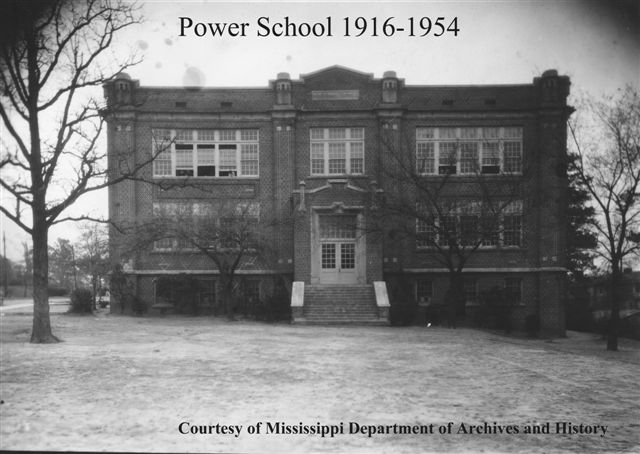
Old Power was situated on the north end of town. Gillespie Street and east-west streets running southward into downtown Jackson were fairly well developed as shown by residences in the 1916 Jackson City directory. There were a few homes on the west side of North State (Canton Road) but most land areas were open fields and meadows. Pinehurst Street was largely undeveloped. (4) The 1946 Sanborn Fire Insurance map indicates Power as facing north. It was a red brick structure with a east and west wing. The building had electricity and was heated by a gas furnace. “Air conditioning” was furnished by open windows. The main entrance was at 709 Pinehurst Street but there were also entrances off North State on the west and a basement entrance facing east. (5) Architecturally, it was built along the lines of other early Jackson grade schools, e.g., Davis, Galloway, Poindexter, George, Lee, (Jim) Hill and Smith-Robinson. The original school building contained five classrooms. The school’s first teachers were first grade, Miss Emma Green; second and third grade, Miss Mabel Bridges; fourth grade, Miss Ruth Reed; fifth and sixth grade, Miss Jim Hailey; and seventh grade, Miss Marcia Gibbs, who was also served as the school’s first principal. (10) (1)
Several former students at old Power remember the structure well. Mrs. Charlotte Charles, Judge Swan Yerger and Mr. Muller Addkison were contemporary students at Power in the late 1930’s and early 1940’s. Mrs. Charles lives in her three generation family home on Gillespie Street. Mr. Addkison lives in his family home on Gillespie Street and Judge Yerger is retired and a resident of northeast Jackson, although he spent much of his boyhood on Poplar. (7) (6) (8) Mrs. Charles remembers Power as follows. “The first floor contained grades 1-3 separated by a large center hall. There was the cafeteria on the south side and two cloakrooms. The second floor contained grades 4-6, an auditorium, adjacent library and the principal’s office. Bathrooms were in the basement.” She remembers the black slate blackboards and the rows of desks bolted to the floor. Desks were wooden with tops that raised over a space for books and supplies. The west yard facing State Street contained wooden swings, see-saws, rings for swinging and a hand propelled merry-go-round. There was also an open lot where the younger kids played their games and occasionally baseball. “We were caught up in the war effort (WWII) as children,” Mrs. Charles said. “We planted a Victory Garden during the war and filled Red Cross boxes to send overseas to troops. Although the cafeteria served good food, some of the neighborhood children, including myself, came home for lunch each day.” (7)
All three of these early Power students were synchronous. All remember the same teachers from their years in the late 1930’s and early 1940’s. According to all, first grades were taught by Miss Minnie Hill and Miss Emma Green; second grade by Miss Mary McLemore and Miss Alfreda Misterfeldt; Third grade, Miss Hattie Casey and Miss May Fulmer; fourth grade, Miss Elaine Mack and Miss Ellisine Butler; fifth grade, Miss Frances Parnell and Miss Marguerite Briscoe; and sixth grade, Mrs. Gray Hillsman and Miss Elizabeth Williamson. The principal was Mr. R.B. Layton (10) Miss Briscoe became principal upon the reassignment of Mr. Layton to Bailey Junior High in 1942, and continued in that role through the closure of old Power in 1954 and until her own retirement in 1960 at the new Power on Riverside Drive. She was replaced in her fifth grade classroom by Miss Nancy Parks. (1) (6) (7) (8)
Jackson oilman and republican philanthropist Billy Mounger remembers one earlier teacher. “I remember a Miss Miazza, my fourth grade teacher, who was good looking”. She became a ‘Mrs.’ Later in the year.” (9) Judge Swan Yerger is most complimentary of his teachers. “These ladies were dedicated to their profession and took great personal interest in their students. They were good examples to follow.” (6) Good behavior was necessary for learning in Power’s early years. According to Judge Yerger, “Miss Green had an enclosed dunce corner similar to a child’s room in her classroom but I don’t remember anyone being sent there. Excessive talking could get you sent to the hall in front of the classroom or you could be sent to the cloakroom.” Miss Green handed out rewards as well as corrections. She would send little slips of paper home with the well-behaved children on which was written the word “good” or other positive comments . Miss McLemore would use a ruler to maintain order. “She would ask a boy to hold out his hand for a mild slap to remind him to mind his teacher.” (6)

Judge Yerger remembers the classroom layouts and entrances on three sides of the building. “There was an auditorium on the second floor,” he said, “with a stage and folding seats. The east side of the building was mostly grass where the primary playground was located. “There was a ‘jungle jim’ see-saws and a slide. The west side was infrequently used and the northside was, of course, the main entrance. There was an alley behind the east yard where kids would ride their bikes and park them in racks located inside the basement door. Some children would be dropped off at the school by their parents in the morning and we would walk home, sometimes stopping by a friend’s house on the way. Children from further away would ride the bus.” Walking and biking were primary means of transportation back when old Power was new. Only a few households could afford the new 1916 Dodge Brothers automobile or its companion the Maxwell. Remember Jack Benny? Judge Yerger remembers an open field across from the school on Pinehurst where the older boys would play softball during recess and after school on a diamond laid out for that purpose. First Presbyterian Church, constructed in 1950, stands on the old sandlot today.
One of Judge Yerger’s many memories of Power was being selected as a Safety Patrol captain in the sixth grade. As a Patrol Boy he helped children cross the busy streets around the school and worked with Sgt. Allen, a Jackson PD motorcycle safety policeman. “Of course there were fewer cars then,” he said. The judge proudly attests “I still have my badge.” Judge Yerger has graduated so let’s be careful when crossing North State. (6) Mr. Addkison remembers a number of his contemporaries from the halls of old Power. Some of these were James Boyd Campbell, Martha Harris, later to become Mrs. Campbell; Frances Heidelberg Coker, Wesley Ann Travis, Bob Travis, James Elliott, Catherine Swaze, Mary Ann McNeil, Martha Henderson, Libby Mounger, Fred Sanders, B.B. McLendon, Shannon Williford. There were also Dennis Brown, Billy Cook, Bobby Davat, David DeCell, Anne Foy, Ronnie Horowitz, Barkie Johnston, Jane Laird, Billie Mahaffey, Bob Merryman, Betty Small, Bobbie Thrower, Dot Tingle, Olive Caldwell, Natalie Chance, Betty Eckles, Jack Flood, Billy Fulgham, Pete Hand, Ralph Hester, Bryant Horne, Chester Jones, Boyne Oxford, George Reed, Billy Riecken, Dolly Ann Shortridge, Claude Smith, Lois Smith, Ernest Spencer, Jimmy Stout, Haskell Turner, Victor Vance, Frances Ann Beecham and Virginia Cavett. (8)
All of Power’s students were not as conventional as Charlotte, Swan and Muller. Billy Mounger began his schooldays at Power in its final kindergarten session in 1931. Author of the book Amidst the Fray (2006), he shares his own experiences at Power School.
“I was an individualist,” Mr. Mounger attests. “I remember when Miss Green would give out the ‘good’ cards. Jane Best got one everyday, but I never got one.” Young Billy relates how he got “run over” when he was in kindergarten. “I came out of kindergarten one day and realized I had missed my ride. There was a crossing policeman at North State but I decided to cut across the Millsaps campus to where we lived at the time. A lady in a Model A Ford ran over me on State Street. She broke my leg, knocked out some teeth and sent me to the Baptist Hospital. I had a cast on my leg for weeks but I have forgiven her.” Mr. Mounger related some of his experiences and impressions at Power to “just being me.” “We didn’t have much playground,” he recalls. “We had to improvise on the lot across the (Pinehurst) street and find things to do during recess in or near the main building. We could also listen to the World Series in the auditorium. One of the things I do remember is that while the building was not that old it was structurally unsound. It was held together with iron rods with stars on each end.” Young Billy made a discovery in his fifth grade class. School administrators had recently changed the grading system from A,B,C, etc. to VS (very satisfactory), S (satisfactory), N (normal) and U (unsatisfactory). The new ratings compared the current student achievement with that of the previous term. “I would take my report card home with a ‘satisfactory’. “My father would be upset because it would appear I wasn’t making progress. I was being compared to my former status not an advancement and hence could do no better. Dad would say, ‘why you’re just normal. You can do better than that’.”
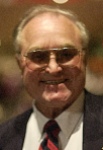
Students were placed in 1930’s Power according to a “tracking method”. “I sat in the third grade with 28 girls and 13 boys,” Mr. Mounger said. “It took a while for me to realize I was in with the ‘higher’ students. Girls must have been smarter than boys in those days – or more motivated.” Regardless of early behavior, leadership comes out in many forms. “Individualist” Billy Mounger was made a captain of the school’s Safety Patrol in the sixth grade. “I got demoted from the captain’s role for kicking a door in the classroom, almost hitting the principal. This even carried over to my high school days. I am probably the only West Point graduate to get kicked out of Junior R.O.T.C. at Central.” Some of Billy Mounger’s friends at Power were Mrs. Homer (Jane) Best, Dr. Harold Caver, Doris Allen Jones of Bryant Galleries, Eddie Guillot, “Boots” Watkins, who headed up the first electrical engineering company in the state; Dickie Deaver who became a scientist, future oral surgeon Sam Sanders and Polly Wells who was selected most beautiful both at Central High and Ole Miss. (9) While “prominent” is a matter of individual taste, all four early Power students were the sons and daughters of pre-war Jackson citizens who grew up in a time of structure, sacrifice and personal responsibility. “We respected our teachers,” Mr. Mounger said, “We considered them on the same level as doctors and always invited them to our events.” Jackson was better for the time these youngsters spent at Power School and the families who sent them there.
Public transportation consisted of city buses which deposited kids at the school corner where crossing guards like Swan Yerger and Billy Mounger helped them across busy streets. Many students walked from home or rode their bicycles. You bought a meal ticket for $1 a week and ate in Mrs. Henrietta Yerger Lewis’ or later Mrs. Margaret Lloyd’s cafeteria. Mr. Mounger remembered Mrs. Lewis, the mother of his friend Van Lewis, as the cafeteria manager when he was at Power. “Those who did not have a dollar for a ticket were provided one by the state. They could also bring lunch from home and eat in the cafeteria with their friends.” Young Billy Mounger remembers well when a single lunch meal cost anywhere from a dime to fifteen cents. “We lived over on Keener Street near the Mississippi Children’s Home when I was at Power. This was before the family moved to St. Ann in Belhaven. My father, who did not make money at the time, would give me ten cents each day for lunch. The fifteen cent lunch included milk and a dessert. My father also would not let me go to school barefooted in warm weather saying he did not want people to think his children had no shoes. Some of my classmates who lived in Belhaven at the time did come to school barefooted and I was jealous of their independence.” (9)
The co-author of this article was an individualist also and a first grader at Power in 1945-46. I’ll tell you a little story about Billy Harvey and old Power School. As mentioned, it was a small building compared to today’s schools as Jackson was a much smaller (and more settled) place. Elementary schools back then were true neighborhood fixtures drawing their students and much of their faculty from well defined areas in the vicinity of their homes. There have always been degrees of learning ability although this fact today is either ignored or blamed on society. In short, some students were smarter than others or had a better learning foundation at home. Unfortunately, all pupils were seated in the same classrooms – even special ed students who were described as “slow”. There was no provision in Mississippi, other than military schools such as Chamberlain-Hunt academy, for “problem” youth. As previously mentioned, I was an individualist.
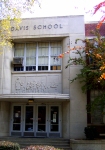
I lived on Manship Street which was in the Power School district. Davis School was on the other side of Fortification. When I was five years old, a debilitating illness prevented my starting in the first grade with my contemporaries. I was sent to the Preventorium in Magee to recover. I did not have TB, but this was a state run facility for all types of youth who had to rehab from a serious illness. While at the Preventorium we were given instruction at the grade level analogous with our chronological age. We had the same readers as the Jackson Public Schools so we still had Dick and Jane but they were read in Simpson County. When I returned to Jackson and my family, my mother, a third grade teacher, was hell bent and determined I would not fall behind. Consequently, she taught me reading, simple math, spelling and basic grammar at a higher level than first grade. Mothers want to be proud of their off-spring, want them to say smart things and if you don’t watch them, will unintentionally encourage their little treasures to be show-offs. Alas.
When I was able to attend public school I was placed in Power. Billy Harvey would be classified today as ADD or some similar type nervous disorder. Then (1946), I was considered to have the heebie jeebies, was an unruly child in spite of corporal discipline at home and spent much time in the hall outside the classroom. One of my tricks after getting “sent to the hall” for putting live grasshoppers in Mrs. Covington’s desk was to go down to the basement and hide. There I would watch old Henry, the janitor, stoke the furnace and he would let me know when Miss Briscoe was looking for me. “Henry,” she would call down the downstairs hall, “Have you seen Billy Harvey?” “No’m,” Henry would lie as I hid under the stairs. Henry and I shared a lot of conversation down in the furnace room, mostly about Miss Briscoe and after a while I would re-emerge saying I had been in the bathroom all that time and wanted to get back to my desk. By then Mrs. Covington, a Godly woman, had forgiven me and Miss Briscoe was none the wiser. I was good until the next time. I have to say after all these years that Henry was my friend. I bribed him with $.18 tins of Prince Albert Tobacco to inform me of impending danger and will have a tin of it ready as soon as I see him in heaven. After that, we are going to look for Miss Briscoe.
Old Power School’s day was done. Yazoo clay, structural problems and a rapidly growing Jackson community had taken their toll on Belhaven’s premier elementary school. First Presbyterian Church needed the land. The neighborhood was attracting many new families. It was time to move on to a new and larger building and in 1954 the school closed, to reopen at 1120 Riverside Drive. And what doors it opened!
Bill and Nan Harvey October 2013

Nan Ertle Harvey is a native of Yazoo County, a graduate of Mississippi College and has lived with her husband Bill in the Belhaven neighborhood since 1994. She worked in a research position in the Department of Microbiology at UMMC, retiring in 2003. Nan’s hobbies are photography, nature study and family research. She is a volunteer at the Mississippi Department of Archives and History. Bill Harvey is a native Jacksonian, living most of his life in Belhaven. A MSU Bulldog, he has had careers in journalism, education and as development director of the Andrew Jackson Council, Boy Scouts of America. Bill enjoys photography, music, writing articles for neighborhood sources and sharing experiences with friends at a local coffee shop. (Text copyright Bill and Nan Harvey, used by permission of Bill and Nan Harvey.)
Sources & Acknowledgements:
1. A History of the Public Schools in Jackson, Mississippi (1832-1972), William
Moore Dalehite, Board of Trustees, Jackson Public Schools, 1974, pp. 138-39;
291-92
2. Publications of the Mississippi Historical Society, edited by Franklin L. Riley,
secretary, Vol. III; Oxford, Mississippi, printed for the Society, 1900, p. 73
Courtesy of the Mississippi department of Archives and History (2013)
3. Story of Jackson, William D. McCain, Vol. I, J.F. Hyer Publishing Company,
Jackson, MS 1953, P.250
4. Jackson City Directory (1916)
5. Sanborn fire Insurance Company maps (1925,1946)
6. Telephone conversations with Judge Swan Yerger (10-03-13) (10-17-13)
7. Interview with Mrs. Charlotte Charles (09-27-13)
8. Interviews with H. Muller Addkison (10-08-13) (10-24-13)
9. Interview with William D. Mounger (10-11-13)
10. Jackson Daily News , Sunday, August 27, 1916, page 5
Special thanks to Mrs. Nancy Smylie, assistant to Dr. Marlynn Martin, Power APAC School for background information on the history of the school and her personal appreciation of its mission; Mrs. Charlotte Charles, Judge Swan Yerger, Mr. H. Muller Addkison and Mr. William D. Mounger for sharing their personal experiences at Power back in the day; Dr. Jean (Sister) Simmons for her extensive contributions to Power APAC School and for leading discussions on both the old and new schools; The Mississippi Department of Archives and History for the photo of the original Power School; A History of the Public Schools in Mississippi (1832-1972), William M. Dalehite 1974 (p. 13), for photo of John Logan Power; and Old Henry, to whom I shall always be grateful.
Father and Son 2
Lighting up the Neighborhood: Bright Lights, Belhaven Nights; the Beginning
Tomorrow Belhaven will illuminate the city with the 14th “Bright Lights, Belhaven Nights”. In this interview from 2014, Councilwoman Virgi Lindsay, former executive director of the Greater Belhaven Neighborhood Foundation (GBNH), looked back on a decade of commitment and celebration.
“Camp Best, who was director of the Fondren Renaissance Foundation at the time, suggested that the GBNH should have a neighborhood festival in Belhaven. We’d been working hard on Fortification Street, and we wanted to do something fun and visible to bring people to the area. Camp and I were having coffee at Cups, and he said that we needed to do a street festival. I agreed; we already had the Belhaven Market going on, which was a Saturday event, but it was clear that we needed to take the next step.”
“There were several occasions that Virgi and I met for coffee at Cups in the early days of Fondren Renaissance Foundation and the Greater Belhaven Foundation,” Camp said. “We were fellow urban warriors in the trenches together back then, supporting each other in whatever way we could. The Fondren Renaissance Foundation had experienced some early successes with our Arts, Eats and Beats, Fondren Unwrapped, Symphony at Sunset and ARTMix (the early precursor to Fondren After Five). All of these events had one purposeful thing in common: get people outdoors in your neighborhood to show the world that it is safe to have fun there. Make it free, so everybody can come, and, use local music and art as the draw.”
Camp said that when he suggested to Virgi that she consider doing the same thing in Belhaven, she worried that they didn’t really have any restaurants or galleries for people to come to back then. “I said it didn’t matter. Make it up; make it look like you do, put the music and artists in the street and people will come. And they did.”
“So in a couple of weeks, I really began thinking about where it could be and when,” Virgi said, “And I began research on a good time to have a festival in Jackson when we wouldn’t have a lot of competition. I quickly found out that every month when the weather could be expected to be great was just full of events. But about that time, Chuck and I went to New Orleans in August, and just happened upon White Linen Night, one of the first ones they held. At that point, it was still a very quiet little event run by the residents on Julia Street. I looked around at this lovely, wonderful neighborhood event, and I thought that if New Orleans can have an outdoors event in August, Jackson, Mississippi can, too.”
Virgi said another reason the Belhaven foundation chose August was because they knew that if they were doing an event in April or October that the competition for sponsorships would be very tough, so scheduling an event in August helped guarantee that the sponsors would be more generous. “And yes, everyone thought we were nuts, but we decided to give it a go. We worked with the theory that it would be the last party of the summer, so we’ve always held Bright Lights, Belhaven Nights the weekend before school starts, the weekend before football season starts.”
Councilwoman Margaret Barrett-Simon said, “It’s exciting that this is the tenth anniversary of Bright Lights, which is an amazing gift that Belhaven gives not only to our neighborhood, but the city itself. We all look forward to it. When we first started on this project, we thought, ‘Who on earth is going to come to an event in the middle of August?’ Well, they all came, they continue to come, and when you look at the diversity of the crowd at Bright Lights, you’ll find that it’s representative of Jackson. I’m so proud of Virgi and her group; they’ve done an incredible job putting this on year after year, and it has become one of the truly outstanding events in our city.”
“The very first year, 2005, Katie Hester and Cheryl Grubbs were the first co-chairmen of the event,” Virgie said. “We were going to open the gates at 5:30, still figuring things out, not sure at all how it would go. We looked up at 5:15, and there a good 500-600 people walking down to Carlisle Street. We had over 1500 people to come that first year. The Belhaven Improvement Association (BIA) volunteered to cook hot dogs and hamburgers in McDade’s parking lot. It was probably the hottest year we’ve ever had, with temperatures hovering around 100 at five in the afternoon. We had some food vendors, and BIA bought every hot dog in McDade’s, but we still ran out of food, we ran out of drinks, we ran out of everything, but as far as we were concerned, that was the most wonderful problem to have.”
Virgi remembers many near misses. “That July, Winn-Dixie had pulled out of the old Jitney 14 space, which was the second time in a short period that the neighborhood almost lost its grocery store. But just four days before the first Bright Lights, Belhaven Nights, GBNH could finally announce that McDade’s was going into the space. “There was a time when we thought that we were having our first festival and our one big anchor in the neighborhood would be lost. It was touch and go, but a week before Bright Lights, Greg McDade moved in. So instead of there being a big, dark, padlocked building at the festival site, we had a vibrant neighborhood grocery with all the energy associated with it.”
“Nobody knew what to expect,” Virgi remembers. “McDade’s ran out of change, everybody ran out of water. Then nine days later came Katrina, and retrospect it’s very emotional when you think about what a wonderful time we all had together that Saturday night, when we came together as a community without any realization that within a very short time we would pull together again in a totally different way. We had a wonderful grounding in the first event; and we came to know that we’re here, we’re together, and looking back it’s a powerful memory.”
“Belhaven has a lot of assets when it comes to putting on a festival of this type,” Virgi said. “For starters, we have a beautiful park we redid and renovated that’s like our ‘town center’. For another thing, we have very willing and cooperative neighbors. Every time a house on Carlisle or Kenwood (the streets where the festival takes place) goes on the market, we get a little worried because we know that the footprint of this festival greatly depends on the participation of the neighbors. And that’s what we’ve got to have, that’s what anyone’s got to have when they’re putting on an event like this, you must have great partners.”
Virgi says that the Foundation stays very true to their original intent, which is promoting all things relating to Greater Belhaven. “I think sometimes festivals get bigger and get growing and losing their originality: they bring in big groups, big bands, national entertainers, import big sponsorships for support. We have really steered clear of that. We could have done it, and a lot of people have told us we should do it, but we have stayed true to our intent of being indigenous. Starting in January, we get almost a million calls from people who are selling or reselling items, but you have to be connected to Belhaven in some way, and we only allow producers, meaning you can’t be a resale vendor. For instance, if you are reselling jewelry that you didn’t make, we will not let you come.”
“Another thing we’re very committed to is keeping the costs low,” Virgi said. “We want this to be a wonderful event for everyone. We have fabulous sponsorships; businesses really reach out and support us, so we can keep the costs low for families. It’s not designed to be a huge fund-raiser for the Greater Belhaven Neighborhood Foundation, but rather an event to promote Greater Belhaven and the City of Jackson.”
Virgi said that her best advice for someone starting a neighborhood festival would be to build a good team. “You can’t do it without a strong team. We’re very fortunate to have Betty Smithson, our programs director, who has been here for six years, and we have Carter Hood, our events coordinator, for the festival this year. We also rely heavily on our volunteers; we have about 100 every year.”
“Oh, and this is another piece of advice: When you name a festival, be sure you know what you’re doing,” Virgi said. “Because when you call something ‘Bright Lights, Belhaven Nights’, you have to have electricity; it was a total shock to us the first year when we realized, ‘Oh, we’ve got to have power!’ The first year, we spent the night before pushing extension cords through mail slots. For three years, we ran it on power from everybody’s house. We now have three temporary power poles, but we still run the event off power cords, and we have literally miles of them.”
“The word is out that Bright Lights, Belhaven Nights is a great festival. Every year, when we think that it can’t get any better, it does.”

